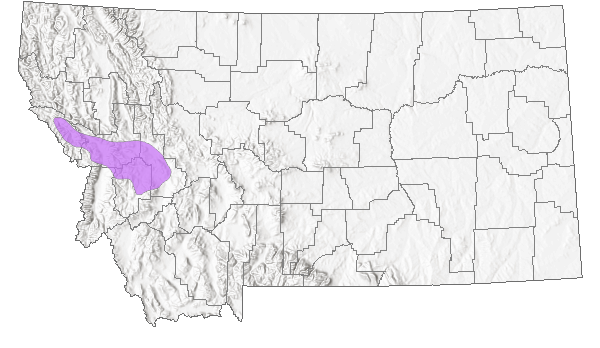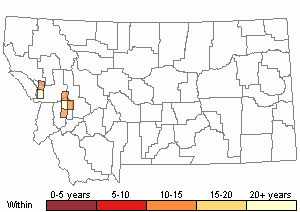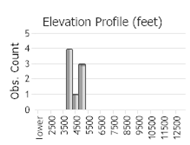View in other NatureServe Network Field Guides
NatureServe
Montana
Utah
Wyoming
Idaho
Wisconsin
British Columbia
South Carolina
Yukon
California
New York
Lyrate Mountainsnail - Oreohelix haydeni
Other Names:
Helix haydeni, Patula haydeni, Patula strigosa haydeni, Pyramidula haydeni
General Description
A distinctive medium to large-sized shell, to 22 mm diameter and 13 mm in height but usually smaller; flattened-heliciform, depressed somewhat in profile, with up to 5 3/4 whorls. Late whorls have coarse irregular striae and prominent raised spiral cords or lirae on both upper and lower surfaces (up to 5 above and 11 below the periphery). The umbilicus is narrow and deep (contained about 5 times in the diameter). The aperture is oval, periphery with a keel. Shell opaque and chalky, color is brownish-gray (dead shells to pearly white); Montana shells lack reddish-brown spiral bands often present in most other species of Oreohelix. Head, neck and tentacles dull ashy gray, darker than the shell (Hendricks 2012, Burke 2013). Internal anatomy is described by Pilsbry (1939) and Fairbanks (1975).
Possible subspecies: O. h. hesperia, O. h. hybrida, and O. h. perplexa in Idaho; O. h. oquirrhensis and O. h. bruneri in Montana.
The description of O. h. bruneri is based on shells from an unknown location in Montana and may not be valid; the material is apparently lost. Fairbanks (1975) felt that two of the four populations he studied in western Montana might be distinct at the subspecific level. With additional study, Montana Oreohelix haydeni may prove to be undescribed species. Included here are Oreohelix n. sp. 6 and n. sp. 31 of Frest and Johannes (1995). Oreohelix n. sp. 31 is considered by Frest and Johannes to be incorrectly attributed to O. h. oquirrhensis.
Diagnostic Characteristics
Late whorls have coarse irregular striae and prominent raised spiral cords or lirae on both upper and lower surfaces (up to 5 above and 11 below the periphery) which are distinctive for Montana Oreohelix.
Species Range
Montana Range
Range Descriptions

 Native
Native
Range Comments
Northern Idaho and northwestern Montana south to Utah and northwestern Colorado (Burke 2013). In Montana, 16 records from 11 sites in three counties west of the Continental Divide: Granite (13), Mineral (2), Missoula (1). Elevation range is 1033 to 1716 m (3390 to 5630 ft). May be relatively abundant at some sites; 66 live animals were collected at the Missoula County site in mid June (Hendricks 2012).
Observations in Montana Natural Heritage Program Database
Number of Observations: 17
(Click on the following maps and charts to see full sized version)
Map Help and Descriptions
Relative Density

Recency



 (Observations spanning multiple months or years are excluded from time charts)
(Observations spanning multiple months or years are excluded from time charts)
Habitat
Often associated with limestone talus and outcrops, sometimes with minimal tree canopy cover on steep south-facing slopes, although at least one site is north-facing. Primary canopy species include Douglas-fir, ponderosa pine, mountain maple; secondary canopy cover may include aspen, ninebark, and serviceberry. Live animals mostly under rocks and in duff or soil accumulations under rocks, sun-bleached shells may be found on the surface (Hendricks 2012).
Reproductive Characteristics
Hermaphroditic (Pilsbry 1939 and Fairbanks 1975).
Management
The known sites are on public (USFS, Bureau of Land Management) and private timberlands. None of these sites have special protection. As with many land mollusks, access to moisture is essential, even in arid locations, so favorable conditions include refugia that maintain high humidity and moderate temperatures for at least part of the year. Removal of forest and shrub canopy is likely detrimental.
Stewardship Responsibility
Threats or Limiting Factors
Habitat occupied by Oreohelix haydeni (low-elevation slopes of open juniper, Ponderosa Pine and Douglas-fir) may be threatened by logging, grazing, weed control, highway development, home development, and fire. Logging and fire in the species' limited habitat, road construction and maintenance, and urban encroachment have already reduced existing populations, and drought has reduced its habitat (Frest and Johannes 1995). The impact of fire retardants on this and other terrestrial mollusks in not known. Little is known about this species, including its susceptibility to disturbance.
References
- Literature Cited AboveLegend:
 View Online Publication
View Online Publication Burke, T. E. 2013. Land snails and slugs of the Pacific Northwest. Corvallis, OR: Oregon State University Press. 344 p.
Burke, T. E. 2013. Land snails and slugs of the Pacific Northwest. Corvallis, OR: Oregon State University Press. 344 p. Fairbanks, H.L., Jr. 1975. A taxonomic study of Oreohelix haydeni in Western Montana. M.A. thesis. University of Montana, Missoula. 113 pp.
Fairbanks, H.L., Jr. 1975. A taxonomic study of Oreohelix haydeni in Western Montana. M.A. thesis. University of Montana, Missoula. 113 pp. Frest, T.J. and E.J. Johannes. 1995. Interior Columbia Basin mollusk species of special concern. Final report to the Interior Columbia Basin Ecosystem Management Project, Walla Walla, WA. Contract #43-0E00-4-9112. 274 pp. plus appendices.
Frest, T.J. and E.J. Johannes. 1995. Interior Columbia Basin mollusk species of special concern. Final report to the Interior Columbia Basin Ecosystem Management Project, Walla Walla, WA. Contract #43-0E00-4-9112. 274 pp. plus appendices. Hendricks, P. 2012. A Guide to the Land Snails and Slugs of Montana. A report to the U.S. Forest Service - Region 1. Montana Natural Heritage Program, Helena, MT. vii + 187 pp. plus appendices.
Hendricks, P. 2012. A Guide to the Land Snails and Slugs of Montana. A report to the U.S. Forest Service - Region 1. Montana Natural Heritage Program, Helena, MT. vii + 187 pp. plus appendices. Pilsbry, H.A. 1939. Land Mollusca of North America (North of Mexico), Volume 1, Part 1. Monograph of the Academy of Natural Sciences of Philadelphia Monograph Number 3 (1): 1-573.
Pilsbry, H.A. 1939. Land Mollusca of North America (North of Mexico), Volume 1, Part 1. Monograph of the Academy of Natural Sciences of Philadelphia Monograph Number 3 (1): 1-573.
- Additional ReferencesLegend:
 View Online Publication
View Online Publication
Do you know of a citation we're missing? Frest, T.J. and E.J. Johannes. 2001. An annotated checklist of Idaho land and freshwater mollusks. Journal of the Idaho Academy of Science 36(2):1-51.
Frest, T.J. and E.J. Johannes. 2001. An annotated checklist of Idaho land and freshwater mollusks. Journal of the Idaho Academy of Science 36(2):1-51. Henderson, J. 1936. Mollusca of Colorado, Utah, Montana, Idaho, and Wyoming, supplement. University of Colorado Studies 23(2): 81-145.
Henderson, J. 1936. Mollusca of Colorado, Utah, Montana, Idaho, and Wyoming, supplement. University of Colorado Studies 23(2): 81-145.
- Web Search Engines for Articles on "Lyrate Mountainsnail"
- Additional Sources of Information Related to "Snails / Slugs"





